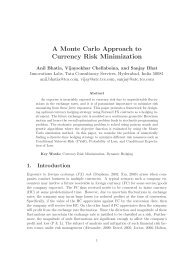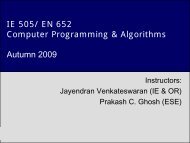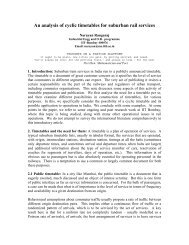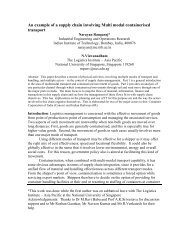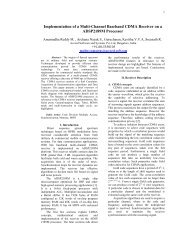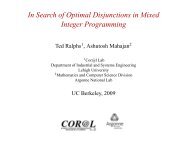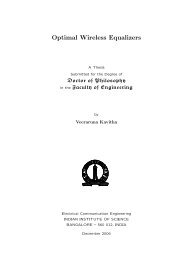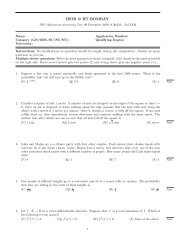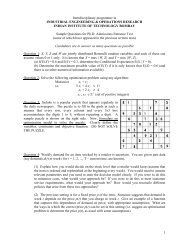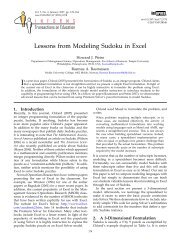1772 IEEE TRANSACTIONS ON INFORMATION THEORY, VOL. 58, NO. 3, MARCH 2012 ODEs has a unique solution for any f<strong>in</strong>ite time. Fur<strong>the</strong>rmore, <strong>the</strong> solution is bounded for any f<strong>in</strong>ite time. Indeed, one has Def<strong>in</strong>e . One can rewrite <strong>the</strong> objective function <strong>in</strong> <strong>the</strong> above optimization problem as (43) with be<strong>in</strong>g <strong>the</strong> upper bound on function , and hence From (42), we have This concludes <strong>the</strong> pro<strong>of</strong> <strong>of</strong> <strong>the</strong> lemma. APPENDIX D PROOF OF LEMMA 2 Under <strong>the</strong> given hypo<strong>the</strong>sis, <strong>the</strong> BS’s policy from (30) and (31) would be . From (27), <strong>the</strong> pay<strong>of</strong>f for mobile 1 under policy is Hence, <strong>the</strong> maximum <strong>of</strong> <strong>the</strong> objective function <strong>in</strong> (43) is achieved under <strong>the</strong> required constra<strong>in</strong>ts by first maximiz<strong>in</strong>g <strong>the</strong> term (<strong>the</strong> constra<strong>in</strong>ts on this alone will be less strict) subject to Def<strong>in</strong>e <strong>the</strong> probability measure for all possible result<strong>in</strong>g from and . Also def<strong>in</strong>e to obta<strong>in</strong> , and <strong>the</strong>n maximiz<strong>in</strong>g <strong>the</strong> term (while ensur<strong>in</strong>g that <strong>the</strong>se variables and <strong>the</strong> optimal variables from <strong>the</strong> previous step jo<strong>in</strong>tly satisfy <strong>the</strong> required constra<strong>in</strong>ts) subject to By <strong>in</strong>dependence, we are <strong>in</strong>terested <strong>in</strong> <strong>the</strong> constra<strong>in</strong>ed optimization problem: If with , <strong>the</strong>n clearly by def<strong>in</strong>ition <strong>of</strong> <strong>the</strong> best strategies ,wehave (42) for all , and so on. Assum<strong>in</strong>g condition ,it is easily seen that (see <strong>the</strong> first equation at <strong>the</strong> top <strong>of</strong> <strong>the</strong> page). Fur<strong>the</strong>r (see <strong>the</strong> second equation at <strong>the</strong> top <strong>of</strong> <strong>the</strong> page). The above def<strong>in</strong>es <strong>the</strong> jo<strong>in</strong>t distribution with prescribed marg<strong>in</strong>als. It is now straightforward to see that <strong>the</strong> conditional distribution is <strong>in</strong>deed . This completes <strong>the</strong> pro<strong>of</strong>. REFERENCES [1] 1xEV:1x Evolution IS-856 TIA/EIA Standard Airl<strong>in</strong>k Overview, Qualcomm, Inc., 2001. [2] High Speed Downl<strong>in</strong>k Packet Access (HSDPA); Overall Description; Stage 2 Technical Specification 3rd Generation Partnership Project; Technical Specification Group Radio Access Network, 2008, 3GPP TS 25.308, Release 8, V8.3.0.
KAVITHA et al.: OPPORTUNISTIC SCHEDULING IN CELLULAR SYSTEMS 1773 [3] S. Mare, D. Kotz, and A. Kumar, “Experimental validation <strong>of</strong> analytical performance models for IEEE 802.11 networks,” <strong>in</strong> Proc. Workshop on Wireless Syst.: Adv. Res. Develop. (WISARD 2010), Jan. 2010, pp. 1–8. [4] G. Bianchi, A. Di Stefano, C. Giaconia, L. Scalia, G. Terrazz<strong>in</strong>o, and I. T<strong>in</strong>nirello, “Experimental assessment <strong>of</strong> <strong>the</strong> back<strong>of</strong>f behavior <strong>of</strong> commercial IEEE 802.11b network cards,” <strong>in</strong> Proc. IEEE INFOCOM 2007, May 2007, pp. 1181–1189. [5] K. S. Karthik and B. Ramamurthi, “Prediction <strong>of</strong> SINR improvement with a directional antenna or antenna array <strong>in</strong> a cellular system,” <strong>in</strong> Proc. 2011 Nat. Conf. Commun. (NCC 2011), Jan. 2011. [6] R. Agrawal, A. Bedekar, R. J. La, and V. Subramanian, S. da Bahia, J. M. de Souza, N. L. S. da Fonseca, and E. A. de Souza e Silva, Eds., “Class and channel condition based weighted proportional fair scheduler,” <strong>in</strong> Proc. Teletraffic Eng. Internet Era (ITC-17), Amsterdam, The Ne<strong>the</strong>rlands, 2001, pp. 553–565. [7] D. M. Andrews, K. Kumaran, K. Ramanan, A. L. Stolyar, R. Vijayakumar, and P. A. Whit<strong>in</strong>g, “<strong>Schedul<strong>in</strong>g</strong> <strong>in</strong> a queue<strong>in</strong>g system with asynchronously vary<strong>in</strong>g service rates,” Prob. Eng. Inf. Sci., vol. 18, pp. 191–217, 2004. [8] P. Bender, P. Black, M. Grob, R. Padovani, N. S<strong>in</strong>dhushayana, and A. Viterbi, “CDMA/HDR: A bandwidth-efficient high-speed wireless data service for nomadic users,” IEEE Commun. Mag., vol. 38, no. 7, pp. 70–77, Jul. 2000. [9] A. Benveniste, M. Métivier, and P. Priouret, Adaptive Algorithms and Stochastic Approximation. New York: Spr<strong>in</strong>ger-Verlag, 1990. [10] S. C. Borst and P. A. Whit<strong>in</strong>g, “Dynamic rate control algorithms for HDR throughput optimization,” <strong>in</strong> Proc. IEEE INFOCOM, 2001, pp. 976–985. [11] E. F. Chaponniere, P. J. Black, J. M. Holtzman, and D. N. C. Tse, “Transmitter Directed Code Division Multiple Access System us<strong>in</strong>g Path Diversity to Equitably Maximize Throughput,” U.S. 6 449 490, Sep. 10, 2002. [12] J. Farrell, “Mean<strong>in</strong>g and credibility <strong>in</strong> cheap-talk games,” Games and Econom. Behav., vol. 5, pp. 514–531, 1993. [13] D. Garg and Y. Narahari, “Foundations <strong>of</strong> Mechanism Design,” Technical Report Indian Institute <strong>of</strong> Science, Department <strong>of</strong> Computer Science and Automation, Bangalore, India, 2006 [Onl<strong>in</strong>e]. Available: http://lcm.csa.iisc.ernet.<strong>in</strong>/game<strong>the</strong>ory/survey/md_nov06.pdf [14] V. Kavitha, E. Altman, R. El-Azouzi, and R. Sundaresan, “Fair schedul<strong>in</strong>g <strong>in</strong> cellular systems <strong>in</strong> <strong>the</strong> presence <strong>of</strong> noncooperative mobiles,” <strong>in</strong> Proc. IEEE INFOCOM 2010, San Diego, CA, Mar. 15–19, 2010. [15] F. P. Kelly, “Charg<strong>in</strong>g and rate control for elastic traffic,” Eur. Trans. Telecommun., vol. 8, pp. 33–37, 1997. [16] Z. Kong, Y.-K. Kwok, and J. Wang, “On game <strong>the</strong>oretic rate-maximiz<strong>in</strong>g packet schedul<strong>in</strong>g <strong>in</strong> non-cooperative wireless networks,” <strong>in</strong> Proc. IEEE Int. Symp. World <strong>of</strong> Wireless, Mobile and Multimedia Netw. (WoWMoM), Jun. 2007, pp. 1–4. [17] D. M. Kreps and J. Sobel, “Signal<strong>in</strong>g,” <strong>in</strong> Handbook <strong>of</strong> Game Theory, R. J. Aumann and S. Hart, Eds. : Elsevier Science B.V., 1994, vol. 2, ch. 25, pp. 849–867. [18] H. J. Kushner and P. A. Whit<strong>in</strong>g, “Convergence <strong>of</strong> proportional-fair shar<strong>in</strong>g algorithms under general conditions,” IEEE Trans. Wireless Commun., vol. 3, no. 4, pp. 1250–1259, Jul. 2004. [19] H. Kushner and G. Y<strong>in</strong>, Stochastic Approximation Algorithms and Applications. New York: Spr<strong>in</strong>ger-Verlag, 1997. [20] X. Liu, E. K. P. Chong, and N. B. Shr<strong>of</strong>f, “A framework for opportunistic schedul<strong>in</strong>g <strong>in</strong> wireless networks,” Comput. Netw., vol. 41, pp. 451–474, 2003. [21] Novatel Merl<strong>in</strong> u870 PC Card, Novatel, 2008 [Onl<strong>in</strong>e]. Available: http://www.novatelwireless.com/products/merl<strong>in</strong>/merl<strong>in</strong>-u870.html [22] P. Nuggehalli, M. Sarkar, K. Kulkarni, and R. R. Rao, “A game-<strong>the</strong>oretic analysis <strong>of</strong> QoS <strong>in</strong> wireless MAC,” <strong>in</strong> Proc. IEEE INFOCOM 2008, Apr. 2008, pp. 1903–1911. [23] A. Ozdaglar and R. Srikant, “Incentives and pric<strong>in</strong>g <strong>in</strong> communications networks,” <strong>in</strong> Algorithmic Game Theory, N. Nisan, T. Roughgarden, E. Tardos, and V. V. Vazirani, Eds. : , 2007, ch. 22, pp. 571–591. [24] L. C. Picc<strong>in</strong><strong>in</strong>i, G. Stampacchia, and G. Vidossich, Ord<strong>in</strong>ary Differential Equations <strong>in</strong> . New York: Spr<strong>in</strong>ger-Verlag, 1978, vol. 39. [25] J. Price and T. Javidi, “Leverag<strong>in</strong>g downl<strong>in</strong>k for efficient upl<strong>in</strong>k allocation <strong>in</strong> a s<strong>in</strong>gle-hop wireless network,” IEEE Trans. Inf. Theory, vol. 53, pp. 4330–4339, Nov. 2007. [26] S. Shakkottai and A. L. Stolyar, S. da Bahia, J. M. de Souza, N. L. S. da Fonseca, and E. A. de Souza e Silva, Eds., “<strong>Schedul<strong>in</strong>g</strong> algorithms for a mixture <strong>of</strong> real-time and non-real-time data <strong>in</strong> HDR,” <strong>in</strong> Proc. Teletraffic Eng. Internet Era (ITC-17), Amsterdam, The Ne<strong>the</strong>rlands, 2001, pp. 793–804. [27] J. Sobel, “Signal<strong>in</strong>g games,” <strong>in</strong> Encyclopedia <strong>of</strong> Complexity and System Science, M. Sotomayor, Ed., forthcom<strong>in</strong>g ed. New York: Spr<strong>in</strong>ger, 2009, to be published. [28] K. Tuna, “Hack<strong>in</strong>g EVDO,” <strong>in</strong> Proc. Defcon 15, 2007. Veeraruna Kavitha received <strong>the</strong> B.E. degree <strong>in</strong> electronics from UVCE, Bangalore, India, <strong>in</strong> 1994. She received <strong>the</strong> M.Sc. (Eng.) and Ph.D. degrees from <strong>the</strong> Electrical Eng<strong>in</strong>eer<strong>in</strong>g and Electrical and Computer Eng<strong>in</strong>eer<strong>in</strong>g Departments <strong>of</strong> <strong>the</strong> Indian Institute <strong>of</strong> Science (IISc), Bangalore, <strong>in</strong> 2002 and 2007, respectively. From 1994 to 2000, she was <strong>in</strong>volved <strong>in</strong> <strong>the</strong> design and development <strong>of</strong> GPS and Voice band modems at Accord S<strong>of</strong>tware and <strong>Systems</strong>, Bangalore. She was an National Board for Higher Ma<strong>the</strong>matics (NBHM) Postdoctoral Fellow at Tata Institute <strong>of</strong> Fundamental Research (TIFR), Bangalore, dur<strong>in</strong>g 2007–2008. S<strong>in</strong>ce 2008, she has been a Postdoctoral Researcher with MAESTRO, INRIA, Sophia Antipolis, France and LIA, University <strong>of</strong> Avignon, France. Her research <strong>in</strong>terests span communication <strong>the</strong>ory, wireless networks, signal process<strong>in</strong>g, game <strong>the</strong>ory, optimal control, and optimization. Eitan Altman (F’10) received <strong>the</strong> B.Sc. degree <strong>in</strong> electrical eng<strong>in</strong>eer<strong>in</strong>g, <strong>the</strong> B.A. degree <strong>in</strong> physics, and <strong>the</strong> Ph.D. degree <strong>in</strong> electrical eng<strong>in</strong>eer<strong>in</strong>g, all from <strong>the</strong> Technion-Israel Institute, Haifa, <strong>in</strong> 1984, 1984, 1990, respectively. In 1990, he received <strong>the</strong> B.Mus. degree <strong>in</strong> music composition from Tel-Aviv University. S<strong>in</strong>ce 1990, he has been a researcher at <strong>the</strong> National Research Institute <strong>in</strong> Computer Science and Control (INRIA) <strong>in</strong> Sophia-Antipolis, France. His areas <strong>of</strong> <strong>in</strong>terest <strong>in</strong>clude network<strong>in</strong>g, stochastic control and game <strong>the</strong>ory. Dr. Altman has been on <strong>the</strong> editorial boards <strong>of</strong> several scientific journals: Wireless Networks (WINET), Computer Networks (COMNET), Computer Communications (Comcom), Journal <strong>of</strong> Discrete Event Dynamic <strong>Systems</strong> (JDEDS), SIAM Journal <strong>of</strong> Control and Optimisation (SICON), Stochastic Models, and <strong>the</strong> Journal <strong>of</strong> Economy Dynamic and Control (JEDC). He received <strong>the</strong> Best Paper Award <strong>in</strong> Network<strong>in</strong>g 2006, <strong>in</strong> Globecom 2007, and <strong>in</strong> IFIP Wireless Days 2009 conferences, and is a coauthor <strong>of</strong> two papers that have received <strong>the</strong> Best Student Paper awards (at QoFis 2000 and at Network<strong>in</strong>g 2002). More <strong>in</strong>formaion can be found at www-sop.<strong>in</strong>ria.fr/members/Eitan.Altman/. Rachid El-Azouzi received <strong>the</strong> Ph.D. degree <strong>in</strong> applied ma<strong>the</strong>matics from <strong>the</strong> Mohammed V University, Rabat, Morocco, <strong>in</strong> 2000. He jo<strong>in</strong>ed <strong>the</strong> National Research Institute <strong>in</strong> Informatics and Control (INRIA) Sophia Antipolis for Postdoctoral and Research Eng<strong>in</strong>eer positions. S<strong>in</strong>ce 2003, he has been a researcher with <strong>the</strong> University <strong>of</strong> Avignon, France. His research <strong>in</strong>terests are, network<strong>in</strong>g games, biologically <strong>in</strong>spired networks, performance evaluation, learn<strong>in</strong>g algorithms, delay tolerant networks, mean field, radio resource management, and epidemic networks. More <strong>in</strong>formation can be found at http://lia.univ-avignon.fr/fileadm<strong>in</strong>/documents/Users/Intranet/chercheurs/elazouzi/<strong>in</strong>dex1.html. Dr. El-Azouzi received <strong>the</strong> Best Paper award <strong>in</strong> <strong>the</strong> Network<strong>in</strong>g 2006, <strong>in</strong> Mobile Ad-hoc and Sensor Networks (MSN 2007), and IEEE Globcom 2007 conferences. Rajesh Sundaresan (S’96–M’00–SM’06) received <strong>the</strong> B.Tech. degree <strong>in</strong> electronics and communication from <strong>the</strong> Indian Institute <strong>of</strong> Technology, Madras, <strong>the</strong> M.A. and Ph.D. degrees <strong>in</strong> electrical eng<strong>in</strong>eer<strong>in</strong>g from Pr<strong>in</strong>ceton University, Pr<strong>in</strong>ceton, NJ, <strong>in</strong> 1996 and 1999, respectively. From 1999 to 2005, he was with Qualcomm Inc. work<strong>in</strong>g on <strong>the</strong> design <strong>of</strong> communication algorithms for wireless modems. S<strong>in</strong>ce 2005, he has been with <strong>the</strong> Department <strong>of</strong> Electrical Communication Eng<strong>in</strong>eer<strong>in</strong>g, Indian Institute <strong>of</strong> Science, Bangalore. His <strong>in</strong>terests are <strong>in</strong> <strong>the</strong> areas <strong>of</strong> communication networks and <strong>in</strong>formation <strong>the</strong>ory.



